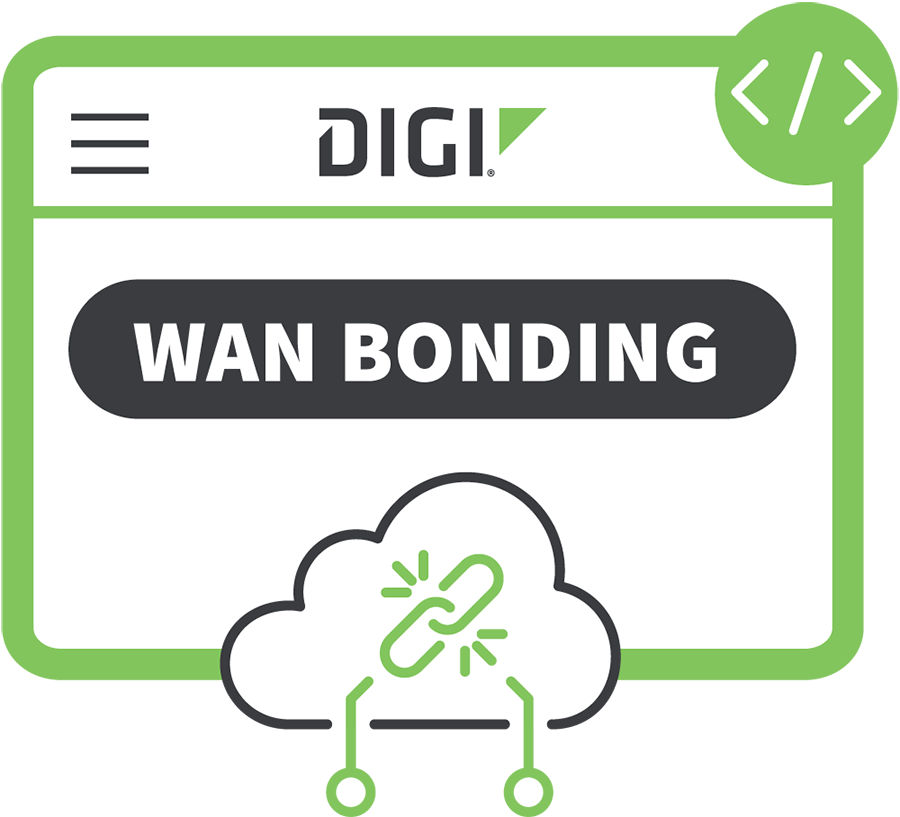


Digi WAN Bonding is a software service that combines multiple wired and wireless connections into a seamless and resilient connectivity solution. It ensures optimal performance and maximum uptime anywhere around the world. Digi WAN Bonding is powered by Bondix S.A.NE. This is a WAN bonding add-on service to Digi Remote Manager® (aka Digi RM - Digi’s cloud management service) that provides ultra fast, ultra reliable network connectivity. With Digi RM, you have a single point of command with added security for your devices.
These incredible resources enable users to centrally set up, deploy and manage the bonding of multiple WAN Internet connections together. The result is a combination of increased throughput speeds, WAN smoothing, packet redundancy, and seamless failover for always-on Internet connectivity. Digi WAN Bonding can scale to hundreds or thousands of sites to provide ultra fast, ultra reliable connections for your entire fleet or network to guarantee you are getting unbeatable connectivity that is always ready, always online.
Digi devices provide a range of connectivity options including cellular failover with features such as Digi Surelink®, policy-based routing and interface bonding. These features are excellent at preventing any external network failures from causing downtime.
Hot failover: Digi’s bonded tunnel interface stays up across all WAN links with no packet loss or failover wait time
WAN aggregation: Combines multiple WAN links for increased speed and bandwidth for one or multiple devices
WAN smoothing: Reduces latency and jitter by sending data through multiple channels simultaneously to eliminate packet loss and maintain connection resiliency
WAN prioritization: Automatically senses or manually sets the best active WAN link and balances traffic accordingly
Packet duplication: Ensures delivery of mission-critical data by replicating packets on multiple WAN links
Simple integration: Digi WAN Bonding is easy to deploy on a range of Digi enterprise (EX), industrial (IX) and transportation (TX) routers in a variety of public and private environments at fixed or mobile locations via Digi Remote Manager
Increased throughput: Digi WAN Bonding offers 100 Mbps, 200 Mbps and 1 Gbps max throughput subscription options
DAL OS is Digi’s standard operating system that is integrated into Enterprise (EX), Industrial (IX) and Transportation (TX) routers, console servers and USB-connected devices. With DAL OS, an extensive set of software features and capabilities are built into firmware that is signed, vetted, and distributed as part of the Digi TrustFence® -approved standards. When a client enables the WAN Bonding feature in Digi Remote Manager and configures their Digi devices to combine their WAN and WWAN interfaces, the default route for any traffic is through the WAN Bonding application. This application then negotiates a tunnel with a virtual private server (VPS). This can be managed by the customer, by Digi Professional Services or by a Digi partner, and begins sending data to the VPS to be recombined and sent onwards. Any replies are sent via the VPS, fragmented appropriately, and sent to whichever interface the device identifies as the most performant and is not saturated. If a device sends a packet via the WWAN connection and proceeds to lose signal before a reply is possible, the VPS will send the reply through the connected WAN interface.
Uptime in vehicles, such as buses and trains, is a major priority for many use cases. Setting up multiple cellular connections with failover through Digi Surelink helps ensure uptime if one connection goes down. However, as the vehicle moves, connections can gradually degrade in quality. With Digi WAN Bonding, multiple connections are intelligently balanced based on quality metrics such as packet loss and latency. As one connection degrades, it is only used when the most effective connection has been saturated. These benefits also make it a good solution for offices, retail, industrial, and energy companies.

Contact the 5Gstore.com sales team Monday through Friday 9am to 6pm CT at 833-547-8673.
Digi WAN Bonding subscription with 100 Mbps max throughput costs $150/ year. A subscription with 200 Mbps max throughput costs $201/ year. Lastly, a subscription with 1 Gbps max throughput costs $266/ year.
DAL OS is Digi's standard operating system that is integrated into Enterprise (EX), Industrial (IX) and Transportation (TX) routers, console servers and USB-connected devices.
Digi TrustFence is a device security framework that simplifies the process of securing connected devices. It enables users to easily integrate device security, device identity, and data privacy capabilities into product design.
Digi's Hot Failover feature means that the bonded tunnel interface stays up across all WAN links with no packet loss or failover wait time.
Digi's Packet Duplication ensures delivery of mission-critical data by replicating packets on multiple WAN links.
Digi's WAN Aggregation means that it can combine multiple WAN links for increased speed and bandwidth for one or multiple devices.
Digi's WAN Prioritization automatically senses or manually sets the best active WAN link and balances traffic accordingly.
Digi's WAN Smoothing reduces latency and jitter by sending data through multiple channels simultaneously to eliminate packet loss and maintain connection resiliency.
Digi WAN Bonding powered by Bondix is a WAN bonding technology available with Digi Remote Manager, enabling increased performance, WAN smoothing, packet redundancy, and failover.